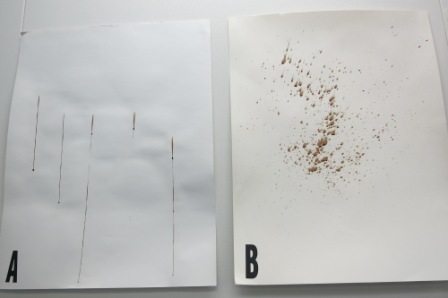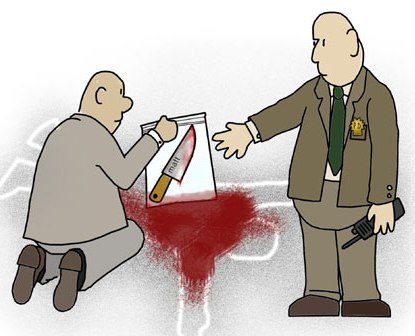Blood Evidence
Nichole Brown Simpson crime scene.
Sometimes, the amount of blood in a murder scene can be quite overwhelming, but the savvy detective can read the reddish-brown liquid like a book. The stuff can even point to where the killer stood when he delivered the fatal blow.
A blood droplet’s direction of travel is easy to determine because of its shape. A drop of blood forms an ellipse when it hits a flat surface. The long axis of the orb is an indication of the travel direction. Also, the ellipse usually has a tail which gives it the appearance of an elongated teardrop. The droplet’s appendage always points away from the victim when it hits a surface from an angle. This is not the case when droplets fall straight to the floor or ground. However, it’s almost always safe to assume the body was directly overhead when the droplet(s) fell.
Blood droplet was traveling from bottom left to upper right. The victim would have been standing somewhere to the lower left of the droplet. Droplets like this are normally caused by a trauma – a gunshot or a blow by an object, such as a baseball bat. This type bloodstain is called a Projected Bloodstain.
Investigators can determine the angle from which the blood droplet struck the flat surface by using the following formula:
Calculating the unknown angle
- = length of ellipse (major axis)
- = width of ellipse (minor axis)
- = angle of impact
The relationship between these variables is:
Blood droplets spatter after falling straight to the ground. This is often seen in self-inflicted, stabbings, and accidental wounds. The further the fall, the wider the spatter. These are called Passive Bloodstains.

Blood spatter pictured above is the result of a direct hit on the wall -no angle. Also a Projected Bloodstain.
“Send that knife to the lab for DNA testing, Joe.”
Quiz: What fatal mistake have these two detectives made?






and thier not wearing gloves so that means their finger prints are on anything they touch.
The seargeant is knelling in blood evidence thier is a no spatter around them so someone didn’t kill him standing up with a gun or a knife so he must of fell to the ground before. Thiers no way to get DNA from a knife Blood=DNA Weapons=Finger Prints. He passed him a plastic when it should have been paper because plastic take away DNA and Finger Prints become invisble like they do if you wear gloves. The knife is signed with a name Matt so it alll adds up. Look for Matt and watch CCTV and their you go you’ve got you killer. 🙂
Lahz – No, and to be perfectly honest, I hadn’t noticed it. Some detective I am, huh? for all I know the killer autographed the murder weapon.
Good eyes!
(Seriously, I think it’s the artists name).
Question. Is there anything significant about the ‘Matt’ on the knife? or is this just the artists name? Sorry if you have already mentioned it.
Elena – I saw GypsyGirl’s answers, and yes, she was right. I remember thinking that she blew my whole quiz first thing, the smarty-pants. (I think she’s in law enforcement or has a very close connection!) Good job, Gypsy Girl. Actually, good job, everyone! Your answers were wonderful.
No chalk outlines.
Kneeling in the blood
No gloves
Yep, they’re all good.
As for not waiting for a crime scene crew…
Not all departments have crime scene investigators. In those departments, the detectives are it. They do it all.
Yep, sine works with circles, too, but I’m not about to get into that. No way. This was bad enough. I just thought it was important to mention so people could see there’s more to an investigatir’s job than drinking coffee and eating donuts. It takes a brain cell or two to do the job well.
Lee, the very first reply, from GypsyGirl, pointed out that it should have been a paper not plastic bag. It was number 2.
I just looked up sine and now all is clear to me – it won’t be to anyone else, but the definition said it’s part of trigonometry. I took high school algebra and trig for the first time in my early 40’s as a birthday present to myself. I know, I’m strange.
Trig made absolutely no sense to me until I finally equated it with Alice’s trip down the rabbit hole. I populated the hole with triangle bits and pieces instead of tables and what not. It’s still too abstract for me, but I trust you!!!!!
Everyone had such great answers, but the one I was looking for was placing the bloody knife in a plastic bag.
The rule of thumb for which kind of bag/container to use is simple. Wet evidence, such as bloody clothing and items containing semen or saliva are packaged in paper. Dry evidence, such as weapons and drugs are packaged in paper or cardboard.
Wet evidence shouldn’t be placed in plastic because the container creates a great environment for bacteria, and bacteria can destroy or degrade DNA.
mnboater – There are computer programs available, but most police departments can barely afford the ten-dollar calculator. In fact, the detectives probably have to buy one if they want it.
In most instances, these calculations would never be performed because murders are usually committed by someone the victim is close to. In those instances, the investigation normally boils down to a process of elimination; witness statements, a little luck, and a lot of intuition and experience.
Solve the MOM puzzle and you usually have your killer. the rest is stuff is icing on the cake.
M – Motive
O – Opportunity
M- Means
So they use calculators to calculate the angle to determine this info today or can they read an analysis from photos and a computer program? I suppose back in the days before calculators, an investigator could learn to get a basic read off the scene of the crime.
As far as the knife, yes, the plastic bag. I have yet though to see any police drama that doesn’t use plastic bags for evidence collection. Wonder why that is. Are there times a plastic bag is appropriate?
Melanie – This should clear up all your confusion. 🙂
Sine Definition: From a triangle
Given any angle we can find the sine of that angle by constructing a right triangle with one vertex of angle q. The sine is equal to the length of the side opposite to q, divided by the length of the triangle’s hypotenuse. In this way, we can find the sine of any q in the range 0 £ q £ 90°.
The common schoolbook definition of the sine of an angle in a right triangle (which is equivalent to the definition just given) is as the ratio of the lengths of the side of the triangle opposite the angle and the hypotenuse.
* The easiest thing to do is to use a calculator with a sine key. When you’ve done the division part of the equation, all you have to do is hit the sine button and it automatically does the conversion. That’s what we do. I certainly hope you don’t think I know what all that gobblety-gook above means.
Okay, I guess I’m more math-impaired than anybody here. What is a sine? I have no clue what that means. I barely made it through Algebra II and Geometry, and took the easiest math I could manage in college. Good think English majors don’t require more, or I never would have graduated. LOL
As for the quiz, the dumb detectives should be looking for prints on the knife, not DNA. They can get that from the blood, which has already been pointed out up above by Joyce. And…by dropping the knife into the plastic bag, they could have smudged the prints. Duh.
Dale – Good eye. You’re exactly right. I’ve made the correction. Thanks.
And, welcome to The Graveyard Shift.
Drawing the chalk line before depositing the “victim’s” blood seems like something an attentive defense attorney would pick up on… 😉
“Blood droplet was traveling from bottom left to upper right. The victim would have been standing somewhere to the lower right right of the droplet.”
Is this an error, or am I misunderstanding something? If the droplet was traveling from bottom left to upper right, doesn’t that mean the victim was standing to the lower left of the droplet?
Becky – I think I gave you the same, but hoped it was a little clearer with the measurements included. I guess not. Sorry.
To solve the equation you’d need a calculator equipped with a sine function, or use a sine function table. I no longer have either. The same calculators and charts are used by highway engineers and inspectors for calculating road and bridge angles.
I’ll try to explain, but math is not my strong suit.
Basically, investigators measure the length and width of the bloodstains. Then they divide the width of the stain by its length. The sum is the width to length ratio. The inverse sine of this ratio must now be calculated and that’s where the calculator or sine function table comes in. The value (from the table or calculated answer) for the ratio is the angle of impact, or AOI.
They turned on the lights? 🙂
FYI, from another math-impaired reader, giving us MORE math doesn’t clear things up! Or did you actually give us less? I can never tell.
Cool stuff.
Interesting subject matter, Lee. It sums up a complex issue in a clear, concise manner.
Joyce, I’m happy to say I never flunked Trig. (Never got that far!)
I like the answers to the quiz. Keep them coming.
Does this help? If the length of the blood droplet is 3.0cm and the width of the droplet is 1.5cm
SIN < = Width 1.5cm Length 3.0cm 0.5 = SIN < < = 30 degrees (converted by using sine function key on calculator or by using a sine function chart) You math experts can probably do this on paper, but me, I need a calculator and a witness to tell me where the victim was standing.
Oh, and Lee, did you really have to throw that math in there? I flunked Trig three times.
I’ll give it a shot.
In addition to the above, they’re not wearing gloves. And knives don’t have DNA–the blood does.
How about a Sgt. Dumbass?
3) Another chalk outline! which means someone has tromped all over the place where the victim fell.
4) That sort of blood pattern – absorbed into the carpet – happens when the victim is lying wound side down – so where did they find a partly bloody dripping knife?
5) Not waiting for the crime scene crew.
6) Potential loss of job if their personnel files show a whole lot of this sort of ‘informal’ investigation skills.
And, while I’m contemplating – What is the relationship between the variables????? Math isn’t my strong suit.
GypsyGirl – Great answers. Let’s see what others have to say. I think I once worked for a guy named Sgt. Dimwit.
1) Sgt. Dimwit is kneeling in the blood evidence.
2) Lt. DumNDummer gave him a plastic bag, when it should have been paper.